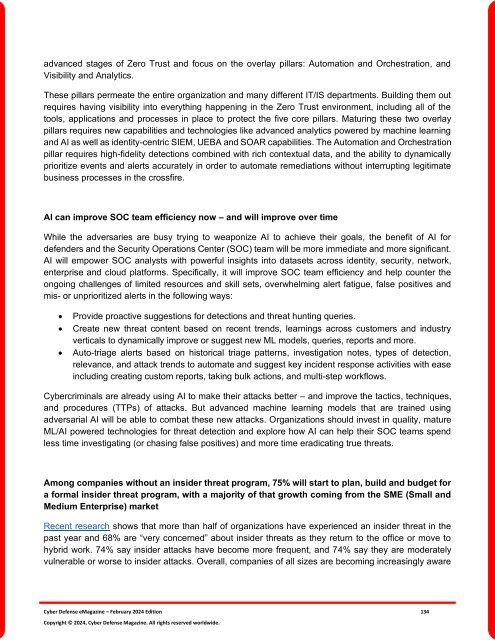The Cyber Defense eMagazine February Edition for 2024
Cyber Defense eMagazine February Edition for 2024 #CDM #CYBERDEFENSEMAG @CyberDefenseMag by @Miliefsky a world-renowned cyber security expert and the Publisher of Cyber Defense Magazine as part of the Cyber Defense Media Group as well as Yan Ross, Editor-in-Chief and many more writers, partners and supporters who make this an awesome publication! 155 page February Edition fully packed with some of our best content. Thank you all and to our readers! OSINT ROCKS! #CDM #CDMG #OSINT #CYBERSECURITY #INFOSEC #BEST #PRACTICES #TIPS #TECHNIQUES
Cyber Defense eMagazine February Edition for 2024 #CDM #CYBERDEFENSEMAG @CyberDefenseMag by @Miliefsky a world-renowned cyber security expert and the Publisher of Cyber Defense Magazine as part of the Cyber Defense Media Group as well as Yan Ross, Editor-in-Chief and many more writers, partners and supporters who make this an awesome publication! 155 page February Edition fully packed with some of our best content. Thank you all and to our readers! OSINT ROCKS! #CDM #CDMG #OSINT #CYBERSECURITY #INFOSEC #BEST #PRACTICES #TIPS #TECHNIQUES
Create successful ePaper yourself
Turn your PDF publications into a flip-book with our unique Google optimized e-Paper software.
advanced stages of Zero Trust and focus on the overlay pillars: Automation and Orchestration, and<br />
Visibility and Analytics.<br />
<strong>The</strong>se pillars permeate the entire organization and many different IT/IS departments. Building them out<br />
requires having visibility into everything happening in the Zero Trust environment, including all of the<br />
tools, applications and processes in place to protect the five core pillars. Maturing these two overlay<br />
pillars requires new capabilities and technologies like advanced analytics powered by machine learning<br />
and AI as well as identity-centric SIEM, UEBA and SOAR capabilities. <strong>The</strong> Automation and Orchestration<br />
pillar requires high-fidelity detections combined with rich contextual data, and the ability to dynamically<br />
prioritize events and alerts accurately in order to automate remediations without interrupting legitimate<br />
business processes in the crossfire.<br />
AI can improve SOC team efficiency now – and will improve over time<br />
While the adversaries are busy trying to weaponize AI to achieve their goals, the benefit of AI <strong>for</strong><br />
defenders and the Security Operations Center (SOC) team will be more immediate and more significant.<br />
AI will empower SOC analysts with powerful insights into datasets across identity, security, network,<br />
enterprise and cloud plat<strong>for</strong>ms. Specifically, it will improve SOC team efficiency and help counter the<br />
ongoing challenges of limited resources and skill sets, overwhelming alert fatigue, false positives and<br />
mis- or unprioritized alerts in the following ways:<br />
• Provide proactive suggestions <strong>for</strong> detections and threat hunting queries.<br />
• Create new threat content based on recent trends, learnings across customers and industry<br />
verticals to dynamically improve or suggest new ML models, queries, reports and more.<br />
• Auto-triage alerts based on historical triage patterns, investigation notes, types of detection,<br />
relevance, and attack trends to automate and suggest key incident response activities with ease<br />
including creating custom reports, taking bulk actions, and multi-step workflows.<br />
<strong>Cyber</strong>criminals are already using AI to make their attacks better – and improve the tactics, techniques,<br />
and procedures (TTPs) of attacks. But advanced machine learning models that are trained using<br />
adversarial AI will be able to combat these new attacks. Organizations should invest in quality, mature<br />
ML/AI powered technologies <strong>for</strong> threat detection and explore how AI can help their SOC teams spend<br />
less time investigating (or chasing false positives) and more time eradicating true threats.<br />
Among companies without an insider threat program, 75% will start to plan, build and budget <strong>for</strong><br />
a <strong>for</strong>mal insider threat program, with a majority of that growth coming from the SME (Small and<br />
Medium Enterprise) market<br />
Recent research shows that more than half of organizations have experienced an insider threat in the<br />
past year and 68% are “very concerned” about insider threats as they return to the office or move to<br />
hybrid work. 74% say insider attacks have become more frequent, and 74% say they are moderately<br />
vulnerable or worse to insider attacks. Overall, companies of all sizes are becoming increasingly aware<br />
<strong>Cyber</strong> <strong>Defense</strong> <strong>eMagazine</strong> – <strong>February</strong> <strong>2024</strong> <strong>Edition</strong> 134<br />
Copyright © <strong>2024</strong>, <strong>Cyber</strong> <strong>Defense</strong> Magazine. All rights reserved worldwide.

















